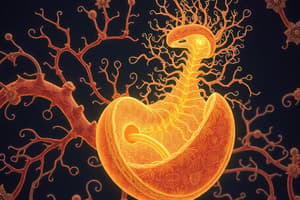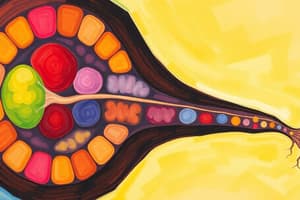Podcast
Questions and Answers
What is the main function of the hypothalamus?
What is the main function of the hypothalamus?
- Regulating speech and language comprehension
- Controlling body temperature, hunger, and mood (correct)
- Processing sensory information from the body
- Establishing emotional states and behavioral drives
Which brain structure is responsible for the transfer of short-term memories to long-term memories?
Which brain structure is responsible for the transfer of short-term memories to long-term memories?
- Hippocampus (correct)
- Fornix
- Amygdala
- Lateral ventricles
What is the role of the basal ganglia?
What is the role of the basal ganglia?
- Regulating circadian rhythms
- Controlling muscle movement and coordination (correct)
- Processing auditory information
- Facilitating decision-making and problem-solving
Which part of the brain is involved in the regulation of emotional states?
Which part of the brain is involved in the regulation of emotional states?
What is the primary function of the right hemisphere of the brain?
What is the primary function of the right hemisphere of the brain?
Which layer of the brain consists of six layers of cells?
Which layer of the brain consists of six layers of cells?
What structure interconnects the two cerebral hemispheres?
What structure interconnects the two cerebral hemispheres?
Which lobe of the brain is primarily responsible for processing visual information?
Which lobe of the brain is primarily responsible for processing visual information?
Brodmann areas are defined primarily by what characteristic?
Brodmann areas are defined primarily by what characteristic?
Which of the following structures is part of the telencephalon?
Which of the following structures is part of the telencephalon?
Which of the following developments occurs first during human embryonic development?
Which of the following developments occurs first during human embryonic development?
What structure is primarily responsible for the induction of the neural plate?
What structure is primarily responsible for the induction of the neural plate?
Which type of neurons are derived from the alar plates of the developing spinal cord?
Which type of neurons are derived from the alar plates of the developing spinal cord?
Anencephaly is characterized by the failure of closure in which of the following structures?
Anencephaly is characterized by the failure of closure in which of the following structures?
What is the primary source of the cerebrospinal fluid (CSF) within the central nervous system?
What is the primary source of the cerebrospinal fluid (CSF) within the central nervous system?
Which structure is responsible for connecting the cerebellum to the brainstem?
Which structure is responsible for connecting the cerebellum to the brainstem?
Which of the following structures develops from the mesencephalon?
Which of the following structures develops from the mesencephalon?
What is the primary function of the thalamus within the diencephalon?
What is the primary function of the thalamus within the diencephalon?
What is the main characteristic of spina bifida occulta?
What is the main characteristic of spina bifida occulta?
What layer of the neural tube contains the neuroblast that develops into neurons?
What layer of the neural tube contains the neuroblast that develops into neurons?
Which of the following structures is derived from the mesoderm during embryonic development?
Which of the following structures is derived from the mesoderm during embryonic development?
How does the process of neurulation begin in human embryonic development?
How does the process of neurulation begin in human embryonic development?
Which signaling molecule inhibits the differentiation of the neural plate during neurulation?
Which signaling molecule inhibits the differentiation of the neural plate during neurulation?
What is the main outcome of closing the anterior neuropore in the neural tube?
What is the main outcome of closing the anterior neuropore in the neural tube?
Which embryonic structure is primarily responsible for the development of the forebrain?
Which embryonic structure is primarily responsible for the development of the forebrain?
What common defect is associated with the failure of anterior neuropore closure?
What common defect is associated with the failure of anterior neuropore closure?
Which layer of the developing neural tube produces white matter in the spinal cord?
Which layer of the developing neural tube produces white matter in the spinal cord?
During which week of development does the eye start to develop?
During which week of development does the eye start to develop?
Which of the following is a potential cause of hydrocephalus during development?
Which of the following is a potential cause of hydrocephalus during development?
What is the primary function of the lateral ventricles within the cerebral hemispheres?
What is the primary function of the lateral ventricles within the cerebral hemispheres?
Which structure is primarily responsible for the interconnections of the left and right hemispheres?
Which structure is primarily responsible for the interconnections of the left and right hemispheres?
Which lobe of the brain is involved in processing sensory information and memory?
Which lobe of the brain is involved in processing sensory information and memory?
What role does the amygdala primarily serve in the limbic system?
What role does the amygdala primarily serve in the limbic system?
Which component of the hypothalamus has a role in controlling circadian rhythms?
Which component of the hypothalamus has a role in controlling circadian rhythms?
What is the function of the neostriatum within the basal ganglia?
What is the function of the neostriatum within the basal ganglia?
Which of the following structures is associated with the function of spatial ability?
Which of the following structures is associated with the function of spatial ability?
Which brain structure is involved in the storage of hormones synthesized by the hypothalamus?
Which brain structure is involved in the storage of hormones synthesized by the hypothalamus?
What is the primary function of the fornix within the limbic system?
What is the primary function of the fornix within the limbic system?
In which area of the brain does sensory stimulus from the right side of the body get processed?
In which area of the brain does sensory stimulus from the right side of the body get processed?
Study Notes
Human Critical Periods of Development
- Gastrulation occurs in the 3rd week (days 15-16), initiating morphogenesis and preparing for organogenesis.
- Development progresses from a bilaminar to a trilaminar disk, forming ectoderm, mesoderm, and endoderm.
- Neurulation begins in the 3rd week and completes by the 4th week, leading to the development of the neural tube and neural tissues (CNS, PNS, ANS).
- Eye development in the 4th week derives from ectoderm, mesoderm, and neural crest cells.
Epiblast and Germ Layer Development
- Detached epiblast cells replace hypoblast cells to form endoderm.
- Migration and invagination of epiblast cells result in the formation of mesoderm.
- Remaining cells in the epiblast develop into the ectoderm.
CNS Development
- Neural plate forms at the dorsal surface of the embryo starting in the 3rd week.
- Longitudinal neural groove and neural folds develop, with the latter leading to neural crest cell formation.
Neural Plate and Tube Formation
- Notochord and paraxial mesoderm induce ectoderm to form the neural plate, influenced by factors such as chordin, noggin, and BMP inhibition.
- Neural folds fuse, forming the neural tube which gives rise to the brain and spinal cord, with cranio-caudal differentiation.
Neural Tube Closure
- Anterior neuropore closes first on the 25th day, followed by closure of the posterior neuropore on the 27th day.
- Full neural tube closure typically completes within 28 days.
Neural Crest Cell Development
- Neural crest cells arise from the sides of the neural tube due to signaling molecules like BMP, Wnt, and FGF.
- Neural crest cells differentiate into diverse structures, including sensory ganglia and Schwann cells.
Primary Brain Vesicles Formation
- Proliferation at the neural tube's cephalic end leads to three primary brain vesicles: prosencephalon, mesencephalon, and rhomboencephalon.
- Each primary vesicle develops further into secondary vesicles, contributing to various brain structures.
Brain Ventricles Development
- Cerebral ventricles arise from secondary brain vesicles, including lateral ventricles from telencephalon and the third ventricle from diencephalon.
- CSF, produced by the choroid plexus, maintains the CNS environment.
Neural Tube Layers and Neuron Development
- Neural tube layers consist of neuroepithelial, mantle, and marginal layers.
- Neuroepithelial cells differentiate into neuroblasts (neurons) and glioblasts (supporting cells).
PNS Development
- PNS is derived from neural crest cells, the neural tube, and mesoderm, including cranial nerves and ganglia.
- Neural crest contributes significantly to the formation of peripheral nerves and supporting cells.
Neural Tube Defects
- High alpha-fetoprotein (AFP) levels in amniotic fluid can indicate neural tube defects (NTDs).
- Folic acid supplementation may help prevent NTDs, including types like spina bifida and anencephaly.
Specific Congenital Malformations
- Anencephaly results from anterior neuropore failure; fatal with high AFP levels.
- Hydrocephalus may develop from cerebral aqueduct stenosis, leading to CSF accumulation.
- Fetal Alcohol Syndrome results from alcohol exposure; includes physical and neurological deficits.
- Holoprosencephaly is characterized by incomplete forebrain division, often due to genetic factors and maternal diabetes.
Functions of the Nervous System
- Receives sensory inputs via receptors that transmit signals to the CNS.
- Integrates inputs to formulate appropriate responses.
- Generates motor output by signaling effectors (muscles and glands).
CNS Structure Overview
- Comprises the cerebrum, brainstem, and cerebellum, each with specific structures and functions.
- Surrounded by meninges and cushioned by CSF for protection and nutrient transport.
Brainstem Functions
- Controls vital life functions, including breathing, heart rate, and sleep.
- Consists of midbrain, pons, and medulla oblongata, each playing distinct roles.
Cerebellum
- Coordinates balance and movement, has extensive neuronal networks for integration.
- Maintains equilibrium and coordinates muscle activities for smooth motion.
Diencephalon Features
- Contains the thalamus (sensory relay station) and hypothalamus (regulates homeostasis and endocrine functions).
Telencephalon
- Comprises cerebral hemispheres and associated structures, influencing cognition, memory, and voluntary movements.
Cerebral Cortex
- Outermost brain layer with distinctive layers, responsible for higher functions including language and perception.
- Divided into lobes: frontal (executive functions), parietal (sensory processing), temporal (memory and language), and occipital (vision).
Hemispheric Functions
- Left Hemisphere: Language processing, analytical skills, and motor control of the right side.
- Right Hemisphere: Creativity, spatial skills, and motor control of the left side.
Brodmann Areas
- Classify regions of the cerebral cortex based on histological differences, including 47 identified areas relating to specific brain functions.
Human Critical Periods of Development
- Gastrulation occurs in the 3rd week (days 15-16), initiating morphogenesis and preparing for organogenesis.
- Development progresses from a bilaminar to a trilaminar disk, forming ectoderm, mesoderm, and endoderm.
- Neurulation begins in the 3rd week and completes by the 4th week, leading to the development of the neural tube and neural tissues (CNS, PNS, ANS).
- Eye development in the 4th week derives from ectoderm, mesoderm, and neural crest cells.
Epiblast and Germ Layer Development
- Detached epiblast cells replace hypoblast cells to form endoderm.
- Migration and invagination of epiblast cells result in the formation of mesoderm.
- Remaining cells in the epiblast develop into the ectoderm.
CNS Development
- Neural plate forms at the dorsal surface of the embryo starting in the 3rd week.
- Longitudinal neural groove and neural folds develop, with the latter leading to neural crest cell formation.
Neural Plate and Tube Formation
- Notochord and paraxial mesoderm induce ectoderm to form the neural plate, influenced by factors such as chordin, noggin, and BMP inhibition.
- Neural folds fuse, forming the neural tube which gives rise to the brain and spinal cord, with cranio-caudal differentiation.
Neural Tube Closure
- Anterior neuropore closes first on the 25th day, followed by closure of the posterior neuropore on the 27th day.
- Full neural tube closure typically completes within 28 days.
Neural Crest Cell Development
- Neural crest cells arise from the sides of the neural tube due to signaling molecules like BMP, Wnt, and FGF.
- Neural crest cells differentiate into diverse structures, including sensory ganglia and Schwann cells.
Primary Brain Vesicles Formation
- Proliferation at the neural tube's cephalic end leads to three primary brain vesicles: prosencephalon, mesencephalon, and rhomboencephalon.
- Each primary vesicle develops further into secondary vesicles, contributing to various brain structures.
Brain Ventricles Development
- Cerebral ventricles arise from secondary brain vesicles, including lateral ventricles from telencephalon and the third ventricle from diencephalon.
- CSF, produced by the choroid plexus, maintains the CNS environment.
Neural Tube Layers and Neuron Development
- Neural tube layers consist of neuroepithelial, mantle, and marginal layers.
- Neuroepithelial cells differentiate into neuroblasts (neurons) and glioblasts (supporting cells).
PNS Development
- PNS is derived from neural crest cells, the neural tube, and mesoderm, including cranial nerves and ganglia.
- Neural crest contributes significantly to the formation of peripheral nerves and supporting cells.
Neural Tube Defects
- High alpha-fetoprotein (AFP) levels in amniotic fluid can indicate neural tube defects (NTDs).
- Folic acid supplementation may help prevent NTDs, including types like spina bifida and anencephaly.
Specific Congenital Malformations
- Anencephaly results from anterior neuropore failure; fatal with high AFP levels.
- Hydrocephalus may develop from cerebral aqueduct stenosis, leading to CSF accumulation.
- Fetal Alcohol Syndrome results from alcohol exposure; includes physical and neurological deficits.
- Holoprosencephaly is characterized by incomplete forebrain division, often due to genetic factors and maternal diabetes.
Functions of the Nervous System
- Receives sensory inputs via receptors that transmit signals to the CNS.
- Integrates inputs to formulate appropriate responses.
- Generates motor output by signaling effectors (muscles and glands).
CNS Structure Overview
- Comprises the cerebrum, brainstem, and cerebellum, each with specific structures and functions.
- Surrounded by meninges and cushioned by CSF for protection and nutrient transport.
Brainstem Functions
- Controls vital life functions, including breathing, heart rate, and sleep.
- Consists of midbrain, pons, and medulla oblongata, each playing distinct roles.
Cerebellum
- Coordinates balance and movement, has extensive neuronal networks for integration.
- Maintains equilibrium and coordinates muscle activities for smooth motion.
Diencephalon Features
- Contains the thalamus (sensory relay station) and hypothalamus (regulates homeostasis and endocrine functions).
Telencephalon
- Comprises cerebral hemispheres and associated structures, influencing cognition, memory, and voluntary movements.
Cerebral Cortex
- Outermost brain layer with distinctive layers, responsible for higher functions including language and perception.
- Divided into lobes: frontal (executive functions), parietal (sensory processing), temporal (memory and language), and occipital (vision).
Hemispheric Functions
- Left Hemisphere: Language processing, analytical skills, and motor control of the right side.
- Right Hemisphere: Creativity, spatial skills, and motor control of the left side.
Brodmann Areas
- Classify regions of the cerebral cortex based on histological differences, including 47 identified areas relating to specific brain functions.
Studying That Suits You
Use AI to generate personalized quizzes and flashcards to suit your learning preferences.
Related Documents
Description
Test your knowledge on the critical periods of human development, particularly focusing on gastrulation, germ layer formation, and CNS development. This quiz covers the key milestones during the early weeks of embryonic development, including neural tube formation and eye development.




